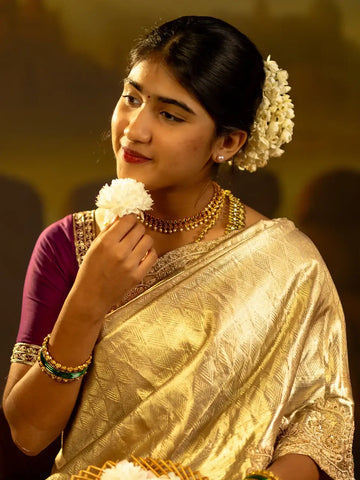
What Makes Banarasi Sarees Unique?
A Banarasi silk saree is more than just a piece of clothing; it is a symbol of India's ancient weaving tradition. The exquisite silks, zari embroidery, and Mughal-inspired designs are the hallmarks of the Banarasi silk weavers' fame.
Finding an original Banarasi saree is crucial whether you're looking for a bridal gown, festival attire, or a classic investment item. This is especially important given the anticipated rise in machine-made imitations by 2025.
Types of Sarees Made of Pure Banarasi Silk
Understanding the different types of Banarasi sarees, each with its own weaving style, is helpful before starting authenticity checks:
- The Katan Banarasi Saree has become known for its strength and luster and is woven from just silk threads.
- Lightweight and covered with rich brocade design is the Organza Banarasi Saree (Kora).
- Soft and circulating, the Georgette Banarasi Saree is frequently worn for party or modern occasions.
- Sheer and glossy, the tissue banarasi saree is ideal for formal occasions like wedding receptions.
- The Shattir Banarasi Saree is a great choice for affordable ethnic fashion.
Depending on the event and style, both of these can be worn as festive sarees, bridal outfits, or even bridesmaid sarees.
Significant Characteristics of an Authentic Banarasi Saree
To identify a real Banarasi saree look for these significant characteristics:
- Heaviness of the pallu and border, typically in zari weaving of silver and gold.
- Common patterns are the floral jaal, Kalga, Bel, and Annapakshi.
- Meena's work consists of colors in a thread work process.
- Contrast color blouse (any contrasting color) or a similar piece of Banarasi blouse fabric with woven borders.
- Small irregularities in the handloom weaving on the reverse side.
Each characteristic illustrates the unique and skilled workmanship of a true handwoven Banarasi saree.
How to Assess the Quality of the Fabric
The feel of pure silk sarees is unique; they are crisp and delicate, and they naturally shine. In contrast to synthetic fibers, the fabric should feel warm when rubbed between your fingertips. Real silk reflects light at various angles, so hold it up to the light. If a loose thread is available, try the burn test on it. Synthetic silk smells like plastic, whereas real silk smells like burnt hair.
Recognizing Genuine vs. Imitative Zari
The legitimacy of a saree is frequently determined by the zari work:
- Zari in its purest form: It has a gentle, vintage shimmer because it is made from silver threads that have been coated in gold.
- Tested zari is copper that has been coated in silver and is frequently used in genuine yet reasonably priced sarees nowadays.
- Imitation zari is frequently made of polyester or plastic, is quite glossy, and isn't very rich.
- A saree is probably not authentic if it contains excessively brassy zari but claims to be authentic Banarasi.
Identifying handloom weaving patterns:
- The weft floats would be on the other side of handwoven Banarasi sarees made from Varanasi.
- Differentiation or small irregularities in the weave (marking authenticity).
- All pallu patterns and border patterns are clear without appearing pixelated or flat.
Look at the designs and density of the weave; authentic sarees feel heavier, as they are of better quality.
Where to Buy Authentic Banarasi Sarees Online
Do buy from reputable suppliers specializing in handloom sarees, especially those who are from and/or based in Varanasi. Look for:
- A clear mention of pure silk fabric and type of zari.
- Options include bridal Banarasi sarees, pastel Banarasi sarees, and Banarasi sarees with contrasting blouses.
- Authenticity and return guarantees.
Check out Diadem's collection of Banarasi Silk Sarees. This is for brides, wedding guests, and saree collectors.
Common Myths About Banarasi Sarees
- Myth: "The only traditional Banarasi sarees are red ones." Truth: Banarasi sarees are now available in dual tones, pastel, gold, emerald green, and burgundy, all of which are just as traditional and luxurious.
- Myth: "A saree is phony if it's light." Truth: Banarasi sarees made of organza and tissue are meant to be light and sheer without compromising on its genuineness.
- Myth: "Sarees created by machines are fine." Truth: A handwoven Banarasi saree has more depth, texture, and craftsmanship than a powerloom saree.
Final Tips for First-Time Buyers
- Do not just depend on the photographs; always look at the product description as well, for the fabric and the type of zari.
- Choose Silk Mark-certified sarees, for guaranteed purity.
- Avoid makers offering "Banarasi silk" sarees for less than INR 2000, as these are likely synthetic or blended.
FAQs
- What distinguishes a powerloom saree from a pure Banarasi saree? Thread floats and minor weaving flaws are visible in handwoven sarees. In zari work, powerloom ones are frequently shallow and very regular. Every GI-tagged saree is handwoven.
- Is genuine gold or silver zari always present in a saree made of pure Banarasi silk? Not always. For longevity and cost-effectiveness, many use tested zari, or copper plated with silver. Only high-end heirloom items include genuine gold zari, which is quite uncommon.
- How much does a real Banarasi silk saree cost? Depending on the quality of the silk, the zari work, and the complexity of the weave, pure Banarasi silk sarees usually cost between ₹8,000 and ₹2,00,000. If very inexpensive, it’s most likely not handwoven or pure.
Conclusion
A pure Banarasi saree is a heritage, not a product. To own one is to own a piece of Indian ethnicity as it weaves heritage, tradition, and legacy. Choosing authenticity means supporting the weaver, perpetuating the tradition, and above all, making an everlasting fashion statement. Explore genuine Banarasi sarees online with Diadem, where style and tradition meet.

